Introduction
Slip rings are essential components in various rotating electrical devices, allowing the transmission of power and data signals across a rotating interface. Their functionality is critical in many applications, such as wind turbines, radar systems, and AC generators. In an era where uninterrupted power and signal transmission are the epitome of efficient and smooth operations, the role of timeless technologies like slip rings cannot be overlooked. They are integral to the smooth and efficient operation of many devices and systems.
This article will delve deeper into the concept of slip rings and examine their functionality, types, and applications.
Table of Contents
- What Is a Slip Ring?
- How Do Slip Rings Work?
- How Do Slip Rings Work in an AC Generator?
- What Causes a Slip Ring to Fail?
- Do Slip Rings Wear Out?
- How to Use Slip Rings?
- Factors That Affect How a Slip Ring Works
- Types of Slip Rings
- Configuration of Slip Rings
- Slip Ring Applications
- Key Advantages of Slip Rings
- Conclusion
- Faqs about How Do Slip Rings Work
What Is a Slip Ring?
A slip ring, also known as a rotary electrical joint or a collector, is an electromechanical device that allows the conduction of electrical power, signals, or both between stationary and rotating parts. A slip ring can be used in any electromechanical system requiring unrestricted, continuous rotation while transmitting power and signals, including power generation and various industrial machinery that require the continuous rotation of equipment while maintaining electrical connections.
How Do Slip Rings Work?
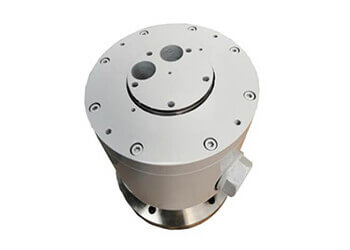
The working of slip rings is predicated on electrical contact, achieved by brushes contacting the ring. The ring and the brush assembly constitute the key components of the slip ring. The brush runs over the exterior surface of the ring during rotation, facilitating the transmission of signals or electricity between the stationary and rotating components.
Metallic brushes make direct contact with the slip rings, creating an electrical connection. Commutating or mercury wetted slip rings deploy mercury for creating a connection. In this case, the liquid metal provides the electrical connection between the stationary and rotating components, effectively lowering friction levels.
Slip rings operate using a rotating assembly consisting of a rotor and a stationary assembly called the stator. The rotor is usually the rotating part, connected to the moving equipment, and the stator is the stationary part, connected to the stationary equipment.
The rotor has well-maintained contact points called brushes, commonly made from precious metal materials to ensure minimal wear and long contact life. These brushes maintain constant contact with the conductive rings on the stator. As the rotor rotates, electrical signals and power can be transmitted through the brushes across the conductive rings—allowing for continuous electrical communication between the rotating and stationary structures without interference or signal degradation.
How Do Slip Rings Work in an AC Generator?
Slip rings play an absolutely vital role in an alternating current (AC) generator, also known as an alternator, to transmit the generated current to the load. The AC generator consists of two primary parts – the rotor, which rotates, and the stator, which remains stationary.
The rotor carries a DC excited field winding that generates a magnetic field. As the rotor spins, its magnetic field induces an AC voltage in the stator windings, due to electromagnetic induction. It’s at this point that the slip rings become crucial components.
The rotor has two slip rings attached to it. Each of these rings is connected to either end of the rotor winding. The outer surface of these rings is conductive and uninterrupted, while the inner surface is insulated from the rotor shaft.
To receive the generated electricity and transmit it further, there are two stationary brushes. Made from soft materials like graphite or copper, these brushes bear lightly but directly onto the slip rings, maintaining electrical contact while the rotor spins. Each brush connects to a separate external circuit.
As the rotor turns, the induced voltage produces an alternating current in the rotor coil. This current isn’t directly usable because the ends of the rotor coil are continuously rotating, altering their position concerning the external stationary circuit.
However, the genius of the slip rings is that they rotate synchronously with the rotor. They ‘slip’ past the brushes, as their name implies, allowing them to maintain constant, uninterrupted contact. The brushes which connect to the stationary external circuit then, collect the current from the slip rings and lead it out of the generator.
Because the brushes are always in touch with the slip rings, regardless of their position, the generated alternating current is smoothly transferred from the rotating rotor coil to the stationary external circuit. This uninterrupted operation lets the AC generator supply power steadily to its load, without any hitches or breaks.
Therefore, in the functioning of an AC generator, the slip rings play the crucial role of ensuring that the generated power is successfully extracted from the rotating part and transmitted to the stationary part. They are paramount in the realization of an AC generator’s purpose – supplying reliable and continuous AC power.
What Causes a Slip Ring to Fail?
As with any electromechanical device, slip rings can experience issues and may sometimes fail due to various factors. Understanding the potential causes of failure will help in preventing operational downtime and extending the life of the slip rings. Below are some of the common reasons that may cause a slip ring to fail.
- Poor Contact between the Brushes and the Rings
One of the primary reasons for slip ring failure is the inadequate contact between the brushes and the rings. This lack of contact can be a result of dirt or contaminant buildup, oxidation, or uneven wear on either the brushes or the rings. Misalignment between the two components may also lead to a poor connection, which can adversely impact the efficiency of power or signal transmission.
- Excessive Wear of the Brush or the Ring
Over time, as the brushes maintain continuous contact with the slip rings, both components are subjected to wear and tear. If the wear rate accelerates due to improper maintenance, uneven force distribution, or use of inferior materials, these components may wear out prematurely, leading to performance deterioration and eventual slip ring failure.
- Overheating Caused by Friction or Excessive Current Flow
The continuous contact between the brushes and the rings creates friction, which generates heat. In addition, high current flow through the slip ring setup can also cause excessive heat. If not appropriately managed or dissipated, the generated heat may cause the slip ring materials to degrade or even deform. Overheating may also lead to the formation of insulating oxide layers on the contact surfaces, impairing the electrical connection and causing the slip ring to fail.
- Mechanical Stress, Shock, or Vibration
Slip rings are typically designed to handle a certain degree of mechanical stress, shock, or vibration. However, if these factors exceed the prescribed limits, they can potentially damage the slip ring components. Excessive mechanical forces may cause deformation, fractures, or misalignment in the contacting surfaces, compromising the quality and reliability of the electrical connection, ultimately resulting in slip ring failure.
In summary, the failure of slip rings can be attributed to a variety of factors that range from poor contact, wear and tear, overheating, or mechanical stress. To prevent failure and ensure smooth functioning, it is paramount to implement proper installation procedures, use high-quality materials, and carry out regular maintenance and inspections. By doing so, the life of slip rings can be extended, and their efficiency and reliability can be optimized, ensuring the seamless transmission of power and signals between stationary and rotating parts across a multitude of applications.
Do Slip Rings Wear Out?
Yes, like any mechanical device that sees regular use, slip rings can and do wear out over time. This wear and tear primarily arise due to the continuous contact made between the brushes and the rings as part of their operation, and it’s an inevitable aspect of the function of slip rings. However, the rate at which they wear out can vary widely based on a host of factors. Let’s delve into these aspects a bit more.
- Why do Slip Rings Wear Out?
The wear and tear of slip rings occur because of friction. When the slip ring turns, brushes keep in constant touch with the rotating ring, facilitating power and signal transfer. This consistent contact inevitably leads to friction, which will slowly wear down both the brush and slip ring over time.
Moreover, the materials used in both the brushes and the slip rings contribute to the wear rate. For instance, brushes made out of metal will typically wear the rings faster than those made out of graphite. But even within those categories, different kinds of metal or graphite brushes will have differing levels of hardness, thus impacting the wear rate.
- How Long Does a Slip Ring Last?
The lifespan of slip rings is not fixed and can vary largely depending on several factors such as the operating conditions, load, speed, the materials used for the brushes and rings, and degree of maintenance. Some slip rings may last only a few thousand hours, while others, particularly those properly maintained and used in less demanding conditions, can last up to several tens of thousands of hours.
- Can the Life of Slip Rings be Extended?
There are a few ways to extend the life of a slip ring:
- Regular Maintenance: Routine cleaning will help keep dust and other contaminants from accelerating the wear process. It also enables early detection of any potential issues.
- Correct Brush Pressure: Adjusting the pressure of the brushes to the right level can lower the wear rate significantly. Too much pressure can hasten the wear, and too little decreases the quality of electrical contact.
- Optimal Operating Conditions: Keeping the environmental conditions for slip rings within their rated specifications is crucial. Environments with high humidity, dust, and high temperatures can accelerate wear.
- Use of Quality Materials: The use of high-grade materials for brushes indeed reduces wear and increases the lifespan considerably.
In essence, while slip rings do wear out over time due to their operating nature, the frequency and rate of this wear can be minimized through careful operational practices, optimal design choices, and regular maintenance. This, in turn, will enhance the durability and longevity of the slip rings, getting the most out of them throughout their operational lifespan.
How to Use Slip Rings?
Being able to use slip rings effectively is key to ensuring their efficiency, longevity, and usefulness in a system. Here are some essential steps to understand when using slip rings.
Installation
- Check Alignment: One of the most critical elements to consider during the installation of slip rings is the alignment. The stationary and rotating parts of the slip ring should be correctly aligned. Misalignment can lead to unfair wear and tear, inducing premature failure.
- Mount Properly: The system which the slip rings are being installed into must be correct to ensure proper functioning. There must be no excessive axial or radial loading on the rotating shaft.
Operation - Avoid Overheating: Overheating can damage the slip rings and cause them to fail. Hence, it is important to ensure that the slip ring does not operate under conditions that surpass its heat dissipation capabilities.
- Respect Load and Speed Limitations: Overloading or operating the slip ring at excessive speeds can cause mechanical and electrical problems. Always operate within the specified load and speed limitations.
- Ensure Steady Electrical Connection: The brushes should be configured to maintain optimal pressure on the slip rings. Too much pressure can cause unnecessary wear, while too little pressure may not provide a steady electrical connection.
Maintenance - Routine Cleaning: It is beneficial to periodically clean the slip ring system to eliminate foreign substances that could damage the components. Compressed air or suitable cleaning solutions can be used for this purpose.
- Routinely Check Brush and Ring Condition: Regularly inspect the condition of the brushes and rings. This will enable the early detection of any visible wear and tear signs and mitigate serious damage.
- Replace Brush or Rings when Needed: Brushes and rings will wear out with time. It is essential to replace any worn-out components immediately to ensure the slip ring continues to function adequately.
In summary, when using slip rings, the importance of proper installation, operation within specified limits, and routine maintenance cannot be overstressed. Adherence to these practices extends the slip ring’s lifespan, reduces the risk of failure, and ensures efficient transmission of power and signals, thereby enhancing the functionality and productivity of the associated system.
Factors That Affect How a Slip Ring Works
The operation of a slip ring, like many other mechanical and electrical devices, is influenced by a number of factors. Some aspects may enhance its performance, while others may pose challenges. Below are some critical factors that can affect how a slip ring works.
- Material of Brushes and Rings
The materials used in brushes and rings significantly affect the performance and lifespan of a slip ring. For instance, softer brush materials, such as graphite, entail less wear on the ring surface but may leave more dust deposits. On the contrary, metal brushes are sturdier but could contribute to quicker wear and tear.
- Electrical Load
The intensity of the electrical load transferred through the slip ring impacts its performance. Higher currents can generate more heat and exacerbate wear between the brushes and the rings.
Therefore, accurately sizing your slip ring to your current requirements is essential for efficient operation and longevity.
- Speed of Rotation
The speed at which the slip ring rotates influences its performance. Rapid rotation can result in significant friction and consequently wear, leading to a shorter lifespan and potentially reduced electrical performance. Additionally, speed can influence the amount of generated heat.
- Alignment and Installation
Proper alignment and installation of the slip ring are crucial to its proper operation. Misalignment can lead to uneven wear or increased friction between the brushes and rings, affecting performance. The mounting location and methods can also impact the accessible cooling, potentially affecting heat dissipation and thus device longevity.
- Operating Environment
The conditions under which the slip ring operates also profoundly impact its functioning. Factors such as temperature, humidity, dust, and corrosive elements can affect the wear rate and electrical performance. Proper protection and maintenance strategies are vital in harsh environments to ensure reliable functioning.
- Maintenance and Upkeep
Regular maintenance, including routine cleaning and timely replacement of worn parts, dramatically impacts a slip ring’s operational efficiency and lifespan. Without proper upkeep, even high-quality slip rings can experience reduced performance and early failure.
In conclusion, numerous factors determine a slip ring’s performance and lifespan. Recognizing and addressing these factors during installation, operation, and maintenance can significantly enhance a slip ring’s effectiveness and operating life, ultimately ensuring the reliable transmission of power or signals between stationary and rotating components in a variety of applications.
Types of Slip Rings
Slip rings are used in various applications that require the transmission of electrical power or signals between stationary and rotating components. There are several types of slip rings available, each with its unique features and advantages. Here is an introduction to 6 common types of slip rings:
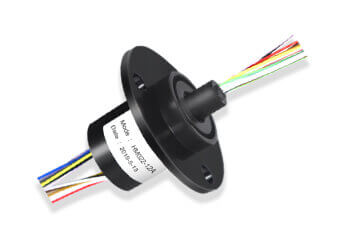
Capsule slip rings, also known as miniature slip rings, are small, compact, and lightweight, making them suitable for use in applications with limited space. These slip rings typically use gold or other precious metal contacts to ensure a low-noise and reliable connection. Capsule slip rings are ideal for communication equipment, medical devices, CCTV systems, robotics, and other small-scale, precision instruments.
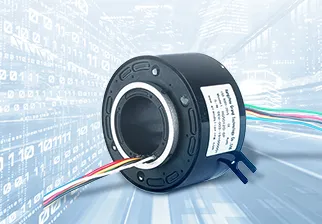
Through-bore slip rings, as their name suggests, have a central hole that allows passage through the slip ring for other components, such as tubing or a shaft. The through-bore design provides greater flexibility for system integration and is commonly used in large industrial equipment, wind turbines, cable reels, and various packaging and processing systems.
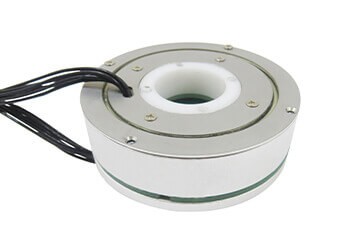
Pancake slip rings feature flat, disk-like designs, with the brushes and rings arranged concentrically around a central axis. They have low axial height, making them suitable for applications where vertical space is limited. However, due to their larger diameters, they are less efficient in terms of heat dissipation compared to cylindrical slip rings and might produce more wear debris. Pancake slip rings are common in radar systems, material handling equipment, and turntables.
- Wireless Slip Rings
Wireless slip rings use inductive coupling or radio frequency (RF) technology to transfer electrical power and signals without the need for physical contact between the stationary and rotating parts. The primary advantage of wireless slip rings is the elimination of wear from brushes and rings, resulting in low maintenance and an extended lifespan. They are ideal for high-speed applications or environments where extremely low friction is necessary. Examples of applications include wireless power transmission for charging devices and communication systems.
- Mercury Wetted Slip Rings
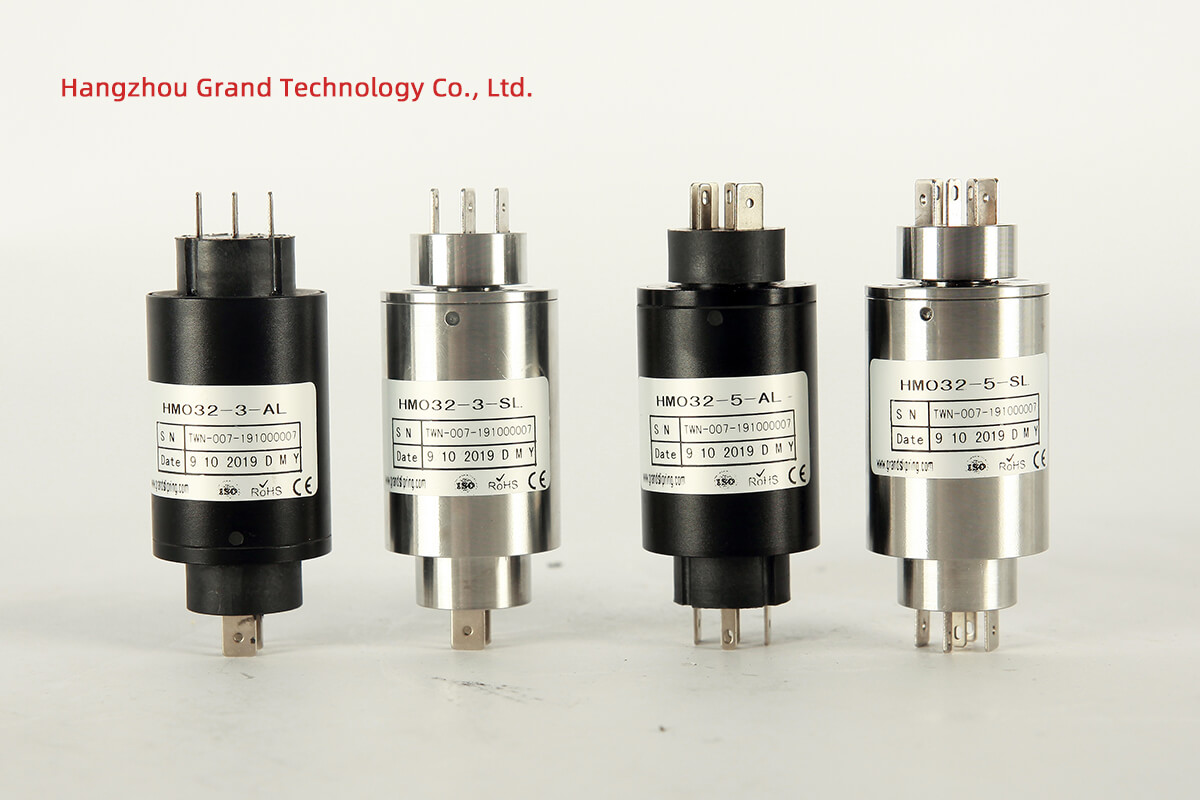
Mercury-wetted slip rings use liquid mercury to form the electrical contact between the brushes and rings. Mercury offers exceptional electrical conductivity and low contact resistance, providing a reliable and low-noise connection. These slip rings are suited to high-speed, high-current applications and require zero maintenance. However, due to the toxicity of mercury, environmental and safety concerns limit their usage to specific applications.
- Fiber Optic Rotary Joints (FORJs)
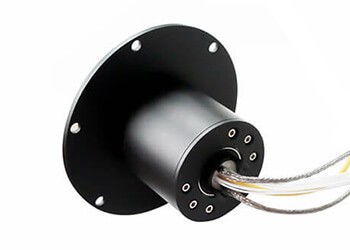
Fiber Optic Rotary Joints (FORJ) transfer optical signals between stationary and rotating components, much like electronic slip rings, but they use optical fibers instead of metallic brushes and rings. This technology allows for interference-free, high-speed data transmission, making it invaluable for telecommunications, high-speed video transmission, and aerospace systems.
In summary, each of these six categories of slip rings offers unique features and advantages. The choice of the most suitable type of slip ring is determined by factors such as available space, application requirements, the environment in which they will be installed, and the specific needs of the system they will be incorporated into.
Configuration of Slip Rings
The configuration of a slip ring refers to its overall structure and design attributes, such as its size, number of channels or paths, types of signals or power it carries, contact material, and housing material. These characteristics vary depending on the application requirements and are key factors that affect the performance and lifespan of a slip ring. Below are several aspects related to the configuration of slip rings:
- Physical Dimensions
The physical size of a slip ring, including its diameter, length, and weight, are determined by the space available in the system it will be installed into. The size will also influence other design aspects, such as the number of channels that can be included.
- Number of Channels
The number of channels refers to how many separate paths for electrical transmission are included in the slip ring. Each path is isolated from the others to prevent cross-talk or interference. The design must ensure that all paths provide consistent and reliable performance.
- Power and Signal Types
Slip rings can be designed to carry both power and signals concurrently. The type and amount of power, as well as the nature of the signals (analog, digital, high-frequency, low-noise, etc.), will influence the choice of contact materials and influence the overall design.
- Contact Material
Different materials can be used for the contacts in a slip ring. Gold is commonly used for low-power signal transfer due to its excellent conductivity and low noise. Other metals like silver or copper may be used for higher-powered applications. The choice of contact material is very important as it significantly affects the performance and reliability of the slip ring.
- Housing Material
The material of the slip ring’s housing is usually selected based on the environment in which the application operates. The housing material should provide sufficient protection against environmental conditions such as temperature, humidity, dust, and corrosive substances. Stainless steel, aluminum, and plastic are among the materials often used for this purpose.
- Installation Configurations
Slip rings can be installed in various configurations depending on the system requirements. Some common installation configurations include end-of-shaft, over-the-shaft, flange-mounted, and pedestal-mounted.
In summary, the configuration of a slip ring largely depends on the specific requirements of the power and signal transmission, the physical constraints of the system, and the environmental conditions in the application area. A correctly configured slip ring is crucial to achieving performance reliability and system productivity.
Slip Ring Applications
Slip rings are versatile electromechanical devices that play a crucial role in various industries by enabling the transmission of electrical power and signals between stationary and rotating components. Below is an expanded description of some common slip ring applications.
- Wind Turbines

Slip rings are vital components in Wind Turbines that connect the stationary tower and the rotating hub, allowing the transmission of power and data between the two. The slip rings enable the continuous rotation of the turbine blades while generating electrical power, avoiding cable twisting and enabling proper control and monitoring of the turbine’s performance.
- Packaging and Processing Machinery

Automation in packaging and processing machines often requires the transfer of electrical power and signals between stationary and rotating parts. Slip rings enable this transmission in equipment such as rotary filling machines, label applicators, stretch wrappers, and printing machines, allowing for uninterrupted, high-speed performance.
- Cable Reels
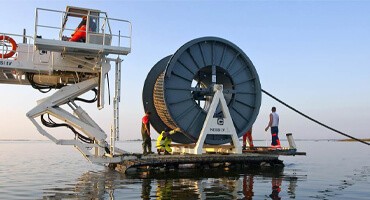
Cable reels, used in various industries for the storage and management of electrical cables, rely on slip rings to transfer power between the stationary base and the rotating drum. This ensures a continuous supply of electrical power without tangling or twisting the cables.
- Medical Devices

Slip rings are commonly found in medical devices, such as CT (Computed Tomography) scanners, where they power and transmit data between the stationary system and rotating gantry. The use of slip rings in these applications is critical for reliable and accurate imaging.
- Robotics

Industrial and collaborative robots often incorporate slip rings for the transmission of electrical power, signals, and data between their stationary bases and rotating joints. The use of slip rings allows the robots to perform complex movements and maintain precise control while optimizing performance, reliability, and efficiency.
- Cranes and Heavy Machinery
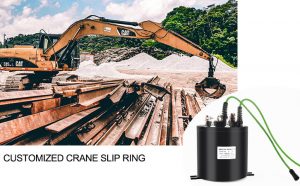
Cranes, excavators, and other heavy machinery often employ slip rings to transfer electrical power and control signals between the stationary and rotating components, such as between the cabin and the rotating platform. By enabling continuous electrical contact, slip rings contribute to the seamless operation and control of these machines.
- Marine and Underwater Applications

Slip rings are used in a variety of marine and underwater applications, such as in remotely operated vehicles (ROVs) and submarines. These slip rings transfer power and signals between the stationary systems and rotating components, such as propellers or imaging systems, while operating in harsh and demanding environments.
- Aerospace and Defense

In aerospace and defense applications, slip rings play a critical role in systems like radar antennas, missile guidance systems, and turret systems. They enable the transfer of power and data signals between stationary and rotating components, ensuring the continuous, accurate functioning of these critical systems.
In conclusion, slip rings serve a diverse range of industries, contributing to the reliable and efficient operation of numerous applications. The versatility and flexibility of slip rings demonstrate their importance in enabling the transmission of electrical power and signals between stationary and rotating components across various systems.
Key Advantages of Slip Rings
Slip rings are essential electromechanical components that form the backbone of various applications that involve the transmission of power, signals, or data between stationary and rotating components. Here is a detailed discussion of the key advantages slip rings offer:
- Continuous Rotation
One of the primary benefits of using slip rings is their ability to facilitate continuous rotation between the stationary and rotating components. By eliminating the need for wires that twist and potentially tangle together, slip rings ensure constant electrical contact, allowing for uninterrupted operation and reducing the risk of mechanical failure.
- High Flexibility
Slip rings come in various shapes, sizes, and configurations, making them adaptable to a wide range of applications and system requirements. This flexibility allows for smoother integration into existing systems and makes it easy to customize slip ring components to suit specific needs, such as the type and number of circuits, the amount of power or data transmitted, and environmental conditions.
- Transferring Multiple Signals Simultaneously
Slip rings can transmit multiple types of signals concurrently, such as power, data, and control signals, without interference. This simultaneous transfer of signals is particularly valuable in applications where bandwidth requirements, latency control, and data integrity are crucial, like in aerospace systems, medical equipment, and communication devices.
- Long Lifespan and Durability
Slip rings are designed for long-lasting reliability and durability, even under demanding operating conditions. High-quality slip rings, when correctly maintained, can deliver exceptional performance results for extended periods. The use of suitable contact materials and proper sealing techniques ensures that slip rings retain their integrity and performance reliability.
- Low Maintenance
Maintenance requirements for slip rings are generally minimal, especially when high-quality components and proper installation and operating procedures are employed. By ensuring low friction and minimal debris generation, modern slip rings reduce the need for frequent cleaning and maintenance, resulting in lower costs, increased productivity, and better overall system performance.
- Supporting High Speeds and Heavy Loads
State-of-the-art slip rings are designed to handle high rotational speeds and heavy loads without sacrificing performance. This capability is critical in high-speed applications like turbines, heavy machinery, and robotics, where mechanical stress can be significant.
- Better Signal Integrity
Slip rings with advanced contact materials and design improvements can offer superior signal integrity, minimal signal loss, and reduced electrical noise. This benefit is essential for applications that require low-noise signal transmission and high-speed data exchanges, such as medical devices, communication systems, and radar antennas.
In summary, slip rings provide several key advantages, ranging from consistent rotational performance and flexibility to increased life span and lower maintenance requirements. These benefits, coupled with their ability to handle multiple signals and maintain signal integrity, make slip rings indispensable components in various industries and applications.
Conclusion
Understanding how slip rings work is essential in various industries, especially where a seamless transmission of electrical power and signals is critical. Slip rings are versatile components that function well in diverse applications such as AC generators, wind turbines, and radar systems. They come in different types and configurations to cater to specific needs. By maintaining contact between rotating and stationary parts, slip rings considerably extend the service life of the components. In conclusion, slip rings play a significant role in the efficient operation of many rotating electrical devices.
Faqs about How Do Slip Rings Work
Q: Can slip rings transmit both power and data signals simultaneously?
A: Yes, slip rings can transfer both power and data signals simultaneously.
Q: What materials are commonly used for brushes?
A: Precious metals like gold, silver, and palladium are commonly used materials for brushes due to their low wear rates and excellent conductive properties.
Q: How long do slip rings last?
A: The lifespan of a slip ring depends on various factors including its design, material quality, working environment, and maintenance.
Q: How can I extend the service life of a slip ring?
A: Proper maintenance, regular cleaning, and ensuring appropriate contact force and alignment can help extend the service life of slip rings.
Q: Are there alternatives to traditional slip rings for transmitting power and signals?
A: Yes, wireless slip rings, or contactless slip rings, use electromagnetic coupling to transmit power and signals without physical contact.
Q: Can slip rings transfer data?
A: Yes, there are specific types of slip rings designed to transmit data and weak signals.
Q: Are slip rings expensive?
A: The cost of slip rings can vary widely depending on their type, specification, and manufacturer.
Q: What materials are used in slip rings?
A: Slip rings can be made from a variety of materials including brass, gold, silver, and copper, among others.
See What We Can Do

